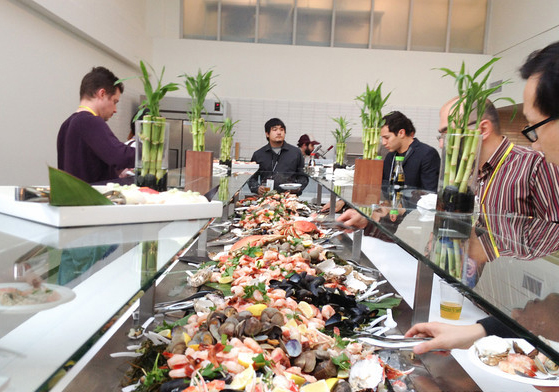
We’ve all heard about the awesome food at Google. In a survey of IT workers conducted earlier this year by Forbes contributor Kate Harrison, “Good Eats” was voted second in a list of favorite employer-provided amenities, right behind “Game Rooms” and ahead of “Physical Health.” Food has definitely become a new workplace perk, and not just in the tech world. More and more, clients across all industries are building amenity spaces that either provide food or support it. Just as most people gravitate to the kitchen at a party, office cafés and cafeterias—whether they are fully catered facilities, a place to heat up a homemade lunch, or merely a place to eat that’s not your desk—have become the heart of the office.
Leveraging real estate
As a former financial services employee, I’m well acquainted with the corporate cafeteria. Back in the day, these spaces were used almost exclusively for meal times, so I was charmed to see my first “café as social space” when the furniture manufacturer Steelcase opened its WorkLife Center at 4 Columbus Circle in New York City in 1996. At the time, it seemed radical that a company would introduce a social space in the midst of the workplace, yet that was exactly the point. The concept has not only endured, but thrived; over the years the New York café has evolved from a single, focused hub space to one that today accommodates large numbers of people throughout the day and evening. Moreover, when Steelcase recently revitalized its Grand Rapids, Mich., headquarters, it started with the cafeteria to set the tone for design of the remainder of the campus.
Café and cafeteria spaces can provide a great way for companies to leverage their real estate. Unlike the quiet rooms, collaboration zones, lounge areas and other amenities that companies build as give-backs to employees in an ever-densifying workplace, these spaces don’t tend to get turned into offices and workstations to accommodate growth. Rather, the café/cafeteria now plays multiple roles. During the day, employees can use them to perform solo work, collaborate in small groups, and hold town hall meetings; after hours, they can serve as event spaces in which employees socialize and clients are entertained, or they can generate income by being hired out for events outside the firm. Whether building a café, grab 'n go or cafeteria, designing these facilities is as much about science and business as it is art. It demands detailed knowledge of the labyrinth of codes, an understanding of the workings and circulation patterns of a professional kitchen and some expertise in inventing any kind of space, in any kind of building. Here are a few trends we have been watching.
Customer experience
According to the NPD Group, a leading market researcher, 40 percent of consumers are loyal to a brand despite promotions offered by other establishments. In retail, this means every aspect of the design must represent the brand; in corporate and institutional food service, the focus is on capturing the culture of the organization. Together with good food, location and price, the artful combination of aesthetics, layout, circulation, service and other amenities creates a customer experience that draws people back time and again.
Variety and healthy choices
Just as we’re seeing a demand for a variety of activity-based space types and transparency in the workplace, we're noticing that people want food choices too—and they want to know what they’re getting. As exhibition cooking, themed action stations and self-serve stations make labeling, ingredients and preparation transparent and accessible have become the norm, the design of these spaces has become more complex. Front-of-house display, delivery, occupancy planning, circulation and point-of-payment must now be seamlessly woven with back-of-house operations like shared preparation, storage, catering and administration.
Scalable use
Eating habits are changing: breakfast meals are on the rise, lunch is becoming the largest meal and people are working (and eating) 24/7. Corporations and institutional cafeterias must plan for peak occupancy and varying degrees of access ranging from full food service to vending and grab and go, as well as to alternative use of the space for training, meetings and special events. For companies wanting to provide convenient access to food and beverage without investing in a cafeteria, honor-system vending is an option, and we’re seeing these stations co-located with break-out lounges and café seating. In either case, the design emphasis is on what’s visible to the customer.
Technology integration
Technology in food service is not only driving greater operational efficiencies but shaping layout and design. Back-of-house is all about assembly line setup and cook/chill systems, remote refrigeration and automatic ice delivery systems—all centrally controlled and linked to building systems. Customer-facing technology includes WiFi throughout, video display of news and entertainment, digital and Web menus, self-service kiosks and point-of-sale systems—all of which drive and determine layout, occupancy and circulation and inform the aesthetics that will enhance the customer experience.
Sustainability
Creating attractive, dynamic environments that deliver peak performance is a significant investment. Protecting that investment means specifying energy-efficient equipment and materials, and furniture and finishes that can endure not only customer use but the abuse of cleaning products and maintenance crews. Additionally, for a space to look good and perform well from day one into the future, the design must ultimately transcend trends and deliver functionality that can adapt to multiple uses and users over time.
A new form of networking
Ironically, one of the best endorsements I found for food-oriented spaces came from Ross Resnick, CEO and founder of Roaming Hunger, an online catering hub and mobile food (food truck) dispatcher. “We consider it a new form of networking," says Resnick. "Senior executives are [standing in line] with the rank-and-file … It’s very democratic.” That's an observation that applies as readily to the cafeteria line as it does to the food truck line. Whether congregating to grab a meal or a snack, seeking a change of scene, or spill over from fully-subscribed conference rooms, these spaces offer opportunities for serendipitous encounters that can promote collegiality and enhance the culture of the organization.
 Fran Ferrone is director of Mancini•Duffy's Center for Workplace Innovation in New York City.
Fran Ferrone is director of Mancini•Duffy's Center for Workplace Innovation in New York City.

